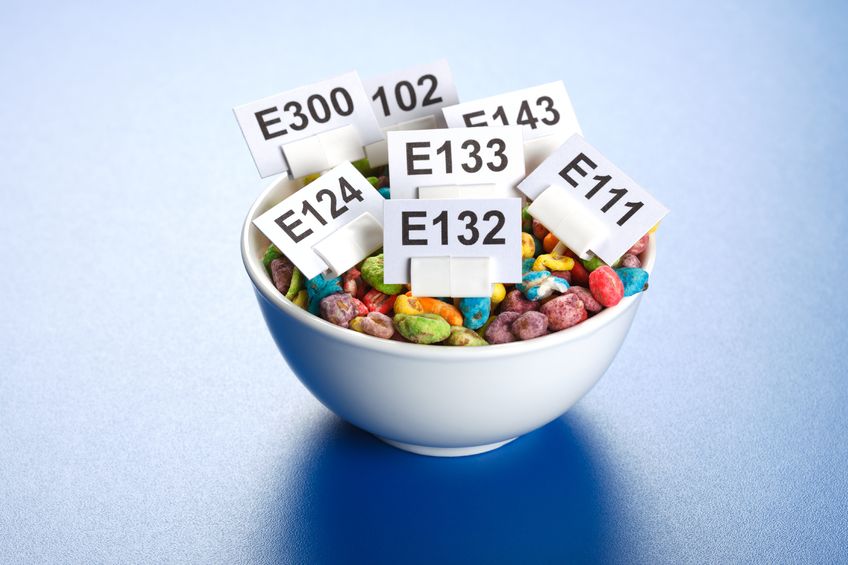When we work with families who have children with ADD/ADHD, OCD, or are on the autism spectrum, one of the first things we do is replace artificial food dyes with healthy, whole food alternatives.
Many artificial food colorings are derived from petroleum, and several contain known carcinogenic (cancer-causing) chemicals, such as benzene--commonly found in numerous processed foods, including macaroni and cheese. Other chemicals have been linked to endocrine/hormonal disruption and breast cancer since they are xenoestrogens.
__________
BLUE DYE linked to: malignant tumor growth, low BP, hives, asthma, allergic reaction, abnormal cell development, hyperactivity
RED DYE linked to: cancer, DNA damage, swelling around the mouth, hives, hyperactivity
YELLOW DYE linked to: food allergy, behavioral issues, cancer, diarrhea, vomiting, migraines, hyperactivity
__________
The use of food dye is pervasive in American food manufacturing. Select most any product from the shelf and flip it over to read which food dyes are included on the ingredient label. Even commercial PICKLES contain artificial food coloring!
Food dye is banned in Norway and Austria. Throughout Europe, foods with synthetic ingredients are required to carry warning labels. Great Britain's food labels warn of an association between food dye and hyperactivity. The US government claims that food coloring additives are "very safe."
According to the FDA website: "Color additives are very safe when used properly," says Linda Katz, M.D., M.P.H., Director of the Office of Cosmetics and Colors in FDA's Center for Food Safety and Applied Nutrition (CFSAN). "There is no such thing as absolute safety of any substance. In the case of a new color additive, FDA determines if there is 'a reasonable certainty of no harm' under the color additive's proposed conditions of use."
Food Babe draws a nice contrast between product labels in the US versus the United Kingdom: http://foodbabe.com/tag/ingredients-banned-in-other-countries/
Many of the United States' most iconic commercial foods--notably fast-food chains--are formulated differently in Europe, using natural ingredients in place of synthetic. If U.S. manufacturers can do it for Europeans, why not for American citizens as well? Unfortunately, demand.
As a collective, Americans are not informed about food. We consume more processed food than any nation on the planet. Students are not learning about nutrition in school, and they certainly are not seeing whole food nutrition modeled in school cafeterias, where processed meats are the standard and ketchup counts as a vegetable. Even American-educated physicians are not receiving significant nutritional education as part of medical school training.
Imagine if Americans were taught proper nutrition as children and grew up reading labels, putting products back on the shelf that did not measure up to healthy standards. U.S. food manufacturing would shift overnight.
NOTE:
The FDA maintains an EAFUS (Everything Added to Food in the United States) database: http://www.accessdata.fda.gov/scripts/fcn/fcnNavigation.cfm?rpt=eafusListing
Many artificial food colorings are derived from petroleum, and several contain known carcinogenic (cancer-causing) chemicals, such as benzene--commonly found in numerous processed foods, including macaroni and cheese. Other chemicals have been linked to endocrine/hormonal disruption and breast cancer since they are xenoestrogens.
__________
BLUE DYE linked to: malignant tumor growth, low BP, hives, asthma, allergic reaction, abnormal cell development, hyperactivity
RED DYE linked to: cancer, DNA damage, swelling around the mouth, hives, hyperactivity
YELLOW DYE linked to: food allergy, behavioral issues, cancer, diarrhea, vomiting, migraines, hyperactivity
__________
The use of food dye is pervasive in American food manufacturing. Select most any product from the shelf and flip it over to read which food dyes are included on the ingredient label. Even commercial PICKLES contain artificial food coloring!
Food dye is banned in Norway and Austria. Throughout Europe, foods with synthetic ingredients are required to carry warning labels. Great Britain's food labels warn of an association between food dye and hyperactivity. The US government claims that food coloring additives are "very safe."
According to the FDA website: "Color additives are very safe when used properly," says Linda Katz, M.D., M.P.H., Director of the Office of Cosmetics and Colors in FDA's Center for Food Safety and Applied Nutrition (CFSAN). "There is no such thing as absolute safety of any substance. In the case of a new color additive, FDA determines if there is 'a reasonable certainty of no harm' under the color additive's proposed conditions of use."
Food Babe draws a nice contrast between product labels in the US versus the United Kingdom: http://foodbabe.com/tag/ingredients-banned-in-other-countries/
Many of the United States' most iconic commercial foods--notably fast-food chains--are formulated differently in Europe, using natural ingredients in place of synthetic. If U.S. manufacturers can do it for Europeans, why not for American citizens as well? Unfortunately, demand.
As a collective, Americans are not informed about food. We consume more processed food than any nation on the planet. Students are not learning about nutrition in school, and they certainly are not seeing whole food nutrition modeled in school cafeterias, where processed meats are the standard and ketchup counts as a vegetable. Even American-educated physicians are not receiving significant nutritional education as part of medical school training.
Imagine if Americans were taught proper nutrition as children and grew up reading labels, putting products back on the shelf that did not measure up to healthy standards. U.S. food manufacturing would shift overnight.
NOTE:
The FDA maintains an EAFUS (Everything Added to Food in the United States) database: http://www.accessdata.fda.gov/scripts/fcn/fcnNavigation.cfm?rpt=eafusListing

 RSS Feed
RSS Feed